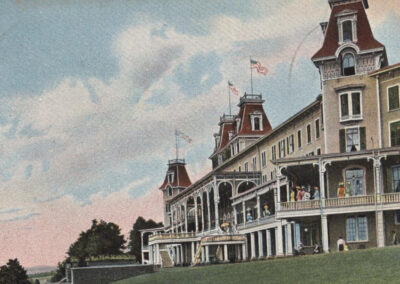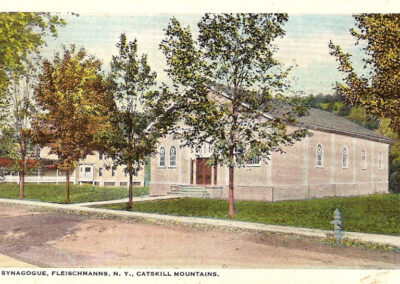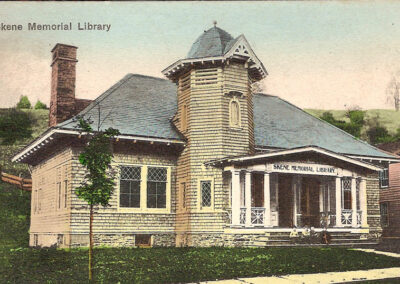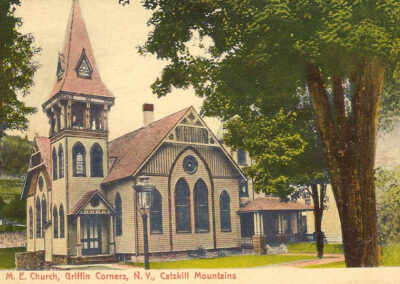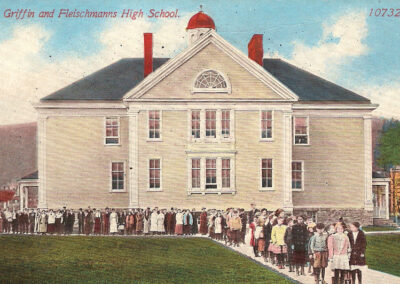Village of Fleischmanns and Clovesville

The Village of Fleischmanns was created in 1913, consolidating what had been two separate areas – Griffins Corners to the west and Fleischmanns, centered around the Ulster & Delaware Railroad depot and the Fleischmanns family compound at the east end of the hamlet. The dividing line between the two areas was Bridge St, where a former hotel (later housing an auction house) still stands.
Dating back to at least the 1830s, the hamlet of Griffin’s Corners grew on what is now the west end of the Village. It was named after Matthew Griffin, an early settler. He was first Postmaster here, was a lawyer, ran a hotel and store, and even served in the State Assembly. The Griffin’s Corners Post Office opened in 1851.
In the 1870s, a railroad from Kingston was built, eventually known as the Ulster & Delaware Railroad. It opened up the area to visitors from New York City, and from farther away. A trip that had taken many difficult hours (or days) on the rough roads suddenly became a matter of hours. Local farmers quickly found that they could make money hosting summer visitors trying to escape the heat in pre-air conditioning New York. A number of hotels and guest houses were built.
Most impressive of all, the wealthy Fleischmann family (of yeast fame and fortune) purchased land above the Railroad overlooking Griffin’s Corners, where they built a family compound with five mansions and many out-buildings. (Picture a 19th-century version of the Kennedy Compound at Hyannis.) This encouraged many others from New York City to build their own summer homes, and for many decades the area around Fleischmanns absolutely boomed in the summers. By 1888 there was a separate Fleischmanns Post Office, serving the west end of town.
Among prominent area residents was Dr. Alexander Skene, a prominent New York City physician who built an estate in nearby Highmount. Skene Memorial Library was built in 1901 in memory of Dr. Skene by his wife. Part of the funds came from Andrew Carnegie, a boyhood friend of Dr. Skene. The landmark building is one of the few libraries in the Catskills to be built as a library. Listed on the State and National Registers of Historic Places, it is still a vital community hub.
In 1906, work began on a dam just north of the Village center, which by 1907 created Lake Switzerland. A number of large hotels were quickly built there. The Regis Hotel still stands, although the lake itself is gone now. But for many years, the lake was the focus for recreation. A noted American painter, Paul Sawyier, spent the last years of his life here in the 1910s, and painted many bright scenes of boats on the lake, and the lively village. In the winter, ice was harvested from the lake to provide cold storage in pre-refrigeration days–almost every home and hotel had an ice house.
HOTELS AND A PARK
Overlooking Fleischmanns, straddling the Ulster/Delaware County line, was the fabled Grand Hotel. One of the largest hotels in the Catskills, it drew well-heeled guests for many decades. Smaller hotels grew in every nook and corner of the Village, and many private homes took in a few boarders. The Breezy Hill Hotel is an example of the evolution of the village. The large hotel overlooked Fleischmanns for many years, and later was the site of the Japanese Camp Furasato. It was recently purchased by the Shaolin order of Buddhists,and is to be the location for a martial arts camp.
When the Fleischmann family left the area in 1913, they donated their park property on Wagner Avenue, where baseball and other summer pastimes entertained throngs of visitors (some reports state that the stands at the Mountain Athletic Club field could hold 5,000 people). In grateful recognition, the expanded Village renamed itself Fleischmanns in their honor. That field is still the focus of recreation in the Village today, with the re-created Mountain Athletic Club (the name of the original Fleischmann family-sponsored team) playing vintage baseball from spring until fall.
World War One brought some decline, and then, as patterns of travel and tourism changed, the number of visitors grew less and less each year. There was some resurgence after World War II, and people today will reminisce about how crowded the streets were then.
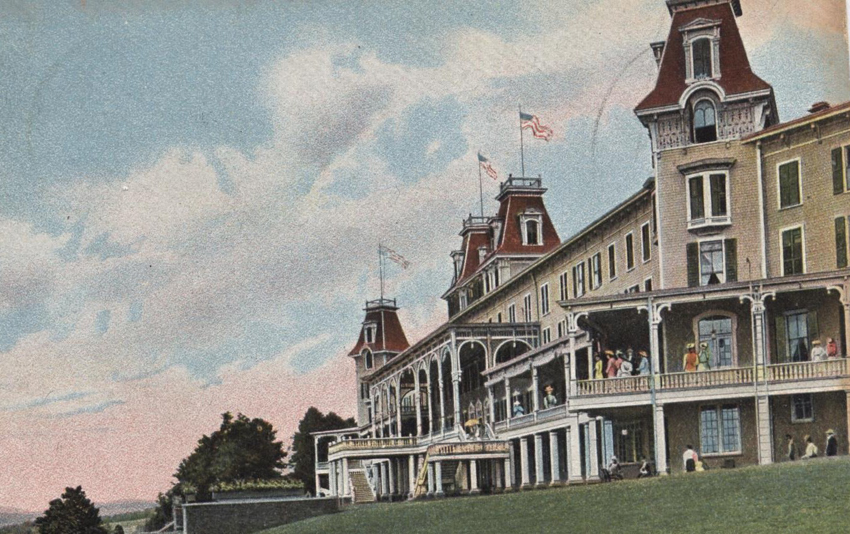
The advent of the automobile brought about a new style of vacationing: motor courts (later motels) replaced the earlier hotels. And there has been a huge increase in the number of second-home owners. Part of this is due to the growth of the ski industry in the area (Belleayre Mountain Ski Center was opened by New York State in 1950). Instead of just a summer destination, Fleischmanns has become a year-round vacation destination.
CLOVESVILLE

Clovesville, just west of Griffins Corners, stretched for about a mile along old Route 28 (then called Main Street). This was a busy, industrial hamlet that included two tanneries, a sawmill and a woolen mill all utilizing the waters of the Bush Kill and the Red Kill streams. There was a blacksmith shop, stores a post office, the Clovesville Cemetery and a Methodist Church, which later became Clovesville Bible Baptist Church and was more recently renamed Cornerstone Bible Baptist Church.
A school, District 8, was situated near where Big Red Kill Road meets old Route 28. This building still stands as a private residence. A creamery operated at that intersection from about 1900 to 1915 when it burned.
VILLAGE OF FLEISCHMANNS AND CLOVESVILLE PHOTO GALLERY
Click for a larger view of each image…
Skene-Memorial-Library-built-1901-in-memory-of-Dr
Skene Memorial Library, built 1901 in memory of Dr. Alexander Skene


